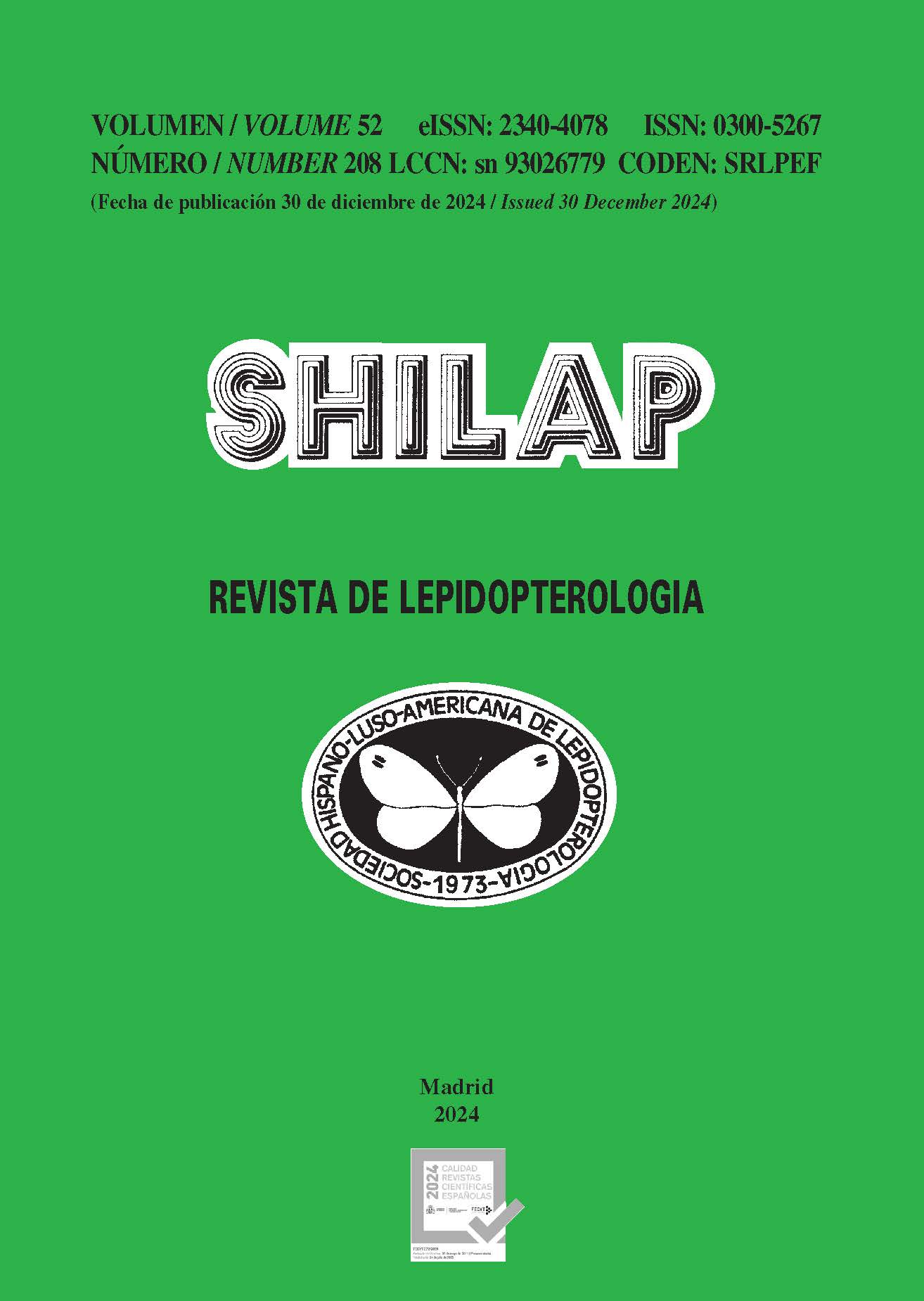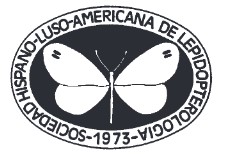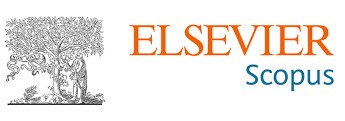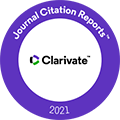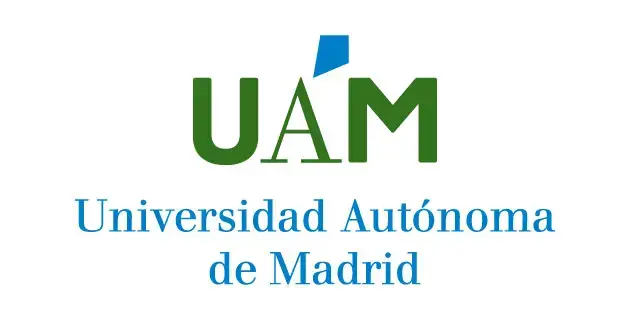Imma phuocbuu Buchsbaum, Chi & Chen, sp. nov. from south Vietnam (Lepidoptera: Immidae)
DOI :
https://doi.org/10.57065/shilap.1016Mots-clés :
Lepidoptera, Immidae, Imma phuocbuu, new species, distribution, biotope, taxonomy, VietnamRésumé
During a faunal survey of Lepidoptera in 2023, Imma phuocbuu Buchsbaum, Chi & Chen, sp. nov. was discovered and represents the first record of the genus in Vietnam. A single male specimen was collected from a transitional biotype between mangrove and semi-deciduous dry lowland forest habitats near the coast. The new species is distinguished from Imma transversella (Snellen, 1878), I. semicitra Meyrick, 1937 and I. semiclara Meyrick, 1929 by differences in wing pattern and genitalia morphology.
Téléchargements
Statistiques globales ℹ️
|
675
Vues
|
145
Téléchargements
|
|
820
Total
|
|
Références
Averyanov, L. V., Loc, PO. K., Hiep, N. T., & Harder, D. K. (2003). Phytogeographyc review of Vietnam and adjected areas of Eastern Indochina. Komarovia, 3, 1-83.
Brooks, T (2010). Conservation planning and priorities, Chapter 11. In N. S. Sodhi & P. R. Ehrlich (eds.). Conservation Biology for All, Oxford, 2010, 199-219. https://doi.org/10.1093/acprof:oso/9780199554232.003.0012 DOI: https://doi.org/10.1093/acprof:oso/9780199554232.003.0012
Brooks, T. M., Mittermeier, R. A., Mittermeier, C. G., da Fonseca, G. A. B., Rylands, A. B., Konstant, W. R., Flick, P., Pilgrim, J., Oldfield, S., Magin, G., & Hilton-Taylors, C. (2002). Habitat Loss and Extinction in the Hotspots of Biodiversity. Conservation Biology, 16(4), 909-923. https://doi.org/10.1046/j.1523-1739.2002.00530.x DOI: https://doi.org/10.1046/j.1523-1739.2002.00530.x
Buchsbaum, U., Grehan, J. R., Chen, M.-Y., Chi, N. M., Pham, D. L., Khai, T. Q., Jones, L. D., & Ignatev, N. (2022). New species of Endoclita C. and R. Felder, 1874 and first record of. E. salvazi from Vietnam (Insecta: Lepidoptera: Hepialidae). Vernate, 41, 267-286.
Buchsbaum, U. (2019). A new species of the genus Ceneressa Obraztsov, 1957 from northern Thailand (Lepidoptera, Erebidae, Arctiinae, Syntomini). Nachrichten des entomologischen Vereins Apollo, N. F., 40(1), 62-64.
Buchsbaum, U., Brüggemeier, F., & Chen, M.-Y. (2014). A new species of the genus Callidrepana Felder, 1861 from Laos (Lepidoptera, Drepanidae). Entomofauna, Supplement, 17, 45-53.
Callighan, C. J. (2009). The Riodinid Butterflies of Vietnam (Lepidoptera). Journal of the Lepidopterologists’ Society, 63(2), 61-82.
Cerny, K., & Pinratana, B. A. (2007). Arctiidae. Moths of Thailand (Vol. 6). Brothers of Saint Gabriel.
Clarke, J. F. G. (1986). Pyralidae and Microlepidoptera of the Marquesas Archipelago. Smithsonian Contributions to Zoology, Washington, 416. https://doi.org/10.5479/si.00810282.416 DOI: https://doi.org/10.5479/si.00810282.416
De Lattin, G. (1967). Grundriss der Zoogeographie. VEB Gustav Fischen Verlag Jena.
Diakonoff, A. (1986). Glyphipterygidae auctorum sensu lato (Glyphipterygidae sensu Meyrick, 1913); Tortricidae: Hilarographini, Choreutidae, Brachodidae (partim), Immidae and Glyphipterygidae. Microlepidoptera Palaearctica (Vol. 7). G. Braun.
Dugdale, J.S., Kristensen, N.P., Robinson, G.S. & Scoble. M.J. (1999) The smaller Microlepidoptera-Grade Superfamiles. In: Kristensen, N.P. (ed.), Handbook of Zoology, volume 4, Arthropoda: Insecta, part 35. Lepidoptera, moths and butterflies, volume 1: Evolution, Systematics, and Biogeography. Walter de Gruyter. DOI: https://doi.org/10.1515/9783110804744.217
Fa, J. E., & Funk, S. M. (2007). Global endemicity centres for terrestrial vertrebrates: an ecoregions approach. Endangered Species Research, 3, 31-52. https://doi.org/10.3354/esr003031 DOI: https://doi.org/10.3354/esr003031
Heppner, J. B. (1977). The status of the Glyphipterigidae and a reassessment of relationships in Yponomeutoid families and ditrysian superfamilies. Journal of the Lepidopterists’ Society, 31, 124-134.
Heppner, J. B. (1982a). Review of the family Immidae, with a world checklist (Lepidoptera: Immoidea). Entomography, 1, 257-279.
Heppner, J. B. (1982b). Synopsis of the Glyphipterigidae (Lepidoptera: Copromorphoidea) of the world. Proceedings of the Entomological Society of Washington, 84, 38-66.
Heppner, J. B. (1991). Faunal Regions and the Diversity of Lepidoptera. Tropical Lepidoptera, 2(Suppl. 1), 1-85.
Holloway, J. D., Kibby, G., & D. Peggie (2001). The Families of Malesian moths and butterflies. Brill. https://doi.org/10.1163/9789004475595 DOI: https://doi.org/10.1163/9789004475595
Kier, G., Kraft, H., Lee, T. M., Jetz, W., Ibisch, P. L., Nowicki, C., Mutke, J., & Barthlott, W. (2009). A global assessment of endemism and species richness across island and mainland regions. PNAS, 106(23), 9322-9327. https://doi.org/10.1073/pnas.0810306106 PMid:19470638 PMCid:PMC2685248 DOI: https://doi.org/10.1073/pnas.0810306106
Küppers, P. V., & Buchsbaum, U. (2015). Phacusa janikornae sp. n. from South Thailand (Lepidoptera, Zygaenidae, Procridinae) with description of the biology. Nachrichten des entomologischen Vereins Apollo, N. F., 36(2/3), 148-152.
Manh, V. Q. (2015). Zoogeographical division of Vietnam based on the Oribatid Mite (Acari: Oribatida) Fauna. Tap Chi Sinh Hoc, 37(3), 353-361. https://doi.org/10.15625/0866-7160/v37n3.7592 DOI: https://doi.org/10.15625/0866-7160/v37n3.7592
Marchese, C. (2015). Biodiversity hotspots: A shortcut for more complicated concept. Global Ecology and Conservation, 3, 297-309. https://doi.org/10.1016/j.gecco.2014.12.008 DOI: https://doi.org/10.1016/j.gecco.2014.12.008
Ministery of Natural Resources and Environment (MONRE) (2020). Vietnam National Biodiversity Strategy to 2020, Vision to 2030. Hanoi.
Mittermeier, R. A., Turner, W. R., Larsen, F. W., Brooks, T. M., & Gascon, C. (2011). Global Biodiversity Conservation: the Critical Role of Hotspots, Chapter 1. In F. E. Zachos & J. C. Habel (eds.). Biodiversity Hotspots. https://doi.org/10.1007/978-3-642-20992-5_1 DOI: https://doi.org/10.1007/978-3-642-20992-5_1
Mittermeier, R. A., Myers, N., Thomsen, J. B., da Fonseca, G. A. B., & Olivieri, S. (1998). Biodiversity Hotspots and Major Tropical Wilderness Areas: Approaches to Setting Conservation Priorities. Conservation Biology, 12(3), 516-520. https://doi.org/10.1046/j.1523-1739.1998.012003516.x DOI: https://doi.org/10.1046/j.1523-1739.1998.012003516.x
Myers, N., Mittermeier, R. A., Mittermeier, C. G., da Fonseca, G. A. B., & Kent, J. (2000): Biodiversity hotspots for conservation priorities. Nature, 403, 853-858. https://doi.org/10.1038/35002501 PMid:10706275 DOI: https://doi.org/10.1038/35002501
Olson, D. M., & Dinerstein, E., (2002). The Global 200: Priority Ecoregions for Global Conservation. Annals of the Missouri Botanical Garden, 89(2), 199-224. https://doi.org/10.2307/3298564 DOI: https://doi.org/10.2307/3298564
Phuong, V. T., & Lin, T. M. (2011). Final report on Forest Ecological Stratification in Vietnam. UN-REDD Programme Vietnam.
Robinson, G. S. (1976). The preparation of slides of Lepidoptera genitalia with special reference to the Microlepidoptera. Entomologist’s Gazette, 27, 127-132.
Robinson, G. S., Tuck, K. R., & Shaffer, M. (1994). A Field Guide to the smaller moths of South-East Asia. Malaysian Nature Society.
Schintlemeister, A. (1997a). Moths of Vietnam with special reference to Mt. Fan-si-pan. Introduction and collection localities. Entomofauna, Supplement, 9(1), 1-12.
Schintlemeister, A. (1997b). Moths of Vietnam with special reference to Mt. Fan-si-pan. Family Notodontidae. Entomofauna, Supplement, 9(4), 33-248.
Schintlmeister, A. (2001). Zoogeographie vietnamesischer Heterocera unter besonderer Berücksichtigung der Zahnspinner (Lepidoptera: Notodontidae). Phyllodrom-Journal. Abhandlungen und Berichte aus der Regenwaldforschung. Tagungsberichte / Phyllodrom-Journal. Abhandlungen und Berichte aus der Regenwaldforschung. Tagungsberichte (Vol. 1, pp. 89-90).
Schintlmeister, A. (2003). The zoogeography of Taiwans’s Notodontidae (Lepidoptera). Journal of the Zoological Society Wallacea, 1, 15-26.
Schintlmeister, A., & Pinratana, B. A. (2007). Moths of Thailand. Notodontidae (Vol. 5). Brothers of Saint Gabriel. https://doi.org/10.1163/9789004260993 DOI: https://doi.org/10.1163/9789004260993
Sechrest, W., Brooks, T. M., de Fonseca, G. A. B., Konstant, W. R., Mittermeier, R. A., Purvis, A., Rylands, A. B., & Gittleman, J. L. (2002). Hotsspots and the conservation of evolutionary history. PNAS, 99(4), 2067-2071. https://doi.org/10.1073/pnas.251680798 PMid:11854502 PMCid:PMC122320 DOI: https://doi.org/10.1073/pnas.251680798
Smith, J. R., Hendershot, J. N., Nova, N., & Daily G. C. (2020). The biogeography of ecoregions: Descriptive power across the regions and taxa. Journal of Biogeography, 47(7), 1413-1426. https://doi.org/10.1111/jbi.13871 DOI: https://doi.org/10.1111/jbi.13871
Sodhi, N. S., Koh, L.-P., Brook, B. W., & Ng, P. K. L. (2004). Southeast Asian biodiversity: an impending disaster. TRENDS in Ecology and Evolution, 19(12), 654-660. https://doi.org/10.1016/j.tree.2004.09.006 PMid:16701328 DOI: https://doi.org/10.1016/j.tree.2004.09.006
Turner, H., Hovenkamp, P., & van Welzen, P. C. (2001). Biogeography of Southeast Asia and the West Pacific. Journal of Biogeography, 28, 217-230. https://doi.org/10.1046/j.1365-2699.2001.00526.x DOI: https://doi.org/10.1046/j.1365-2699.2001.00526.x
Wondroff, D. S. (2010). Biogeography and conservation in Southeast Asia: shows 2.7 million years of repeated environmental fluctuations affect today’s patterns and the future of the remaining refugial-phase biodiversity. Biodiversity Conservation, 19(4), 919-941. https://doi.org/10.1007/s10531-010-9783-3 DOI: https://doi.org/10.1007/s10531-010-9783-3
Vu, L. V. & Vu, C. Q. (2011), Diversity pattern of Butterfly communities (Lepidoptera, Papilionoidea) in different habitat types in a tropical rain forest of southern Vietnam. DOI: https://doi.org/10.5402/2011/818545
Téléchargements
Publiée
Comment citer
Numéro
Rubrique
Licence
(c) Tous droits réservés Ulf Buchsbaum, Mei-Yu Chen, Nguyen Minh Chi 2024

Ce travail est disponible sous la licence Creative Commons Attribution 4.0 International .
L'auteur conserve ses droits de marque et de brevet sur tout procédé ou procédure figurant dans l'article.
L'auteur conserve le droit de partager, distribuer, exécuter et communiquer publiquement l'article publié dans SHILAP Revista de lepidopterología, avec une reconnaissance initiale de sa publication dans SHILAP Revista de lepidopterología.
L'auteur conserve le droit de procéder à une publication ultérieure de son travail, de l'utilisation de l'article à sa publication dans un livre, à condition d'indiquer sa publication initiale dans le SHILAP Revista de lepidopterología.
Chaque soumission à SHILAP Revista de lepidopterología doit être accompagnée d'une acceptation des droits d'auteur et de la mention de la paternité. En les acceptant, les auteurs conservent le droit d'auteur de leur travail et acceptent que l'article, s'il est accepté pour publication par le SHILAP Revista de lepidopterología, soit autorisé à être utilisé et distribué sous une licence "Creative Commons Attribution 4.0 International" (CC BY 4.0) ce qui permet une utilisation, une distribution et une reproduction sans restriction sur tout support, à condition que l'auteur et la source originale soient mentionnés.
Vous pouvez lire ici les informations de base et le texte légal de la licence. L'indication de la licence CC BY 4.0 doit être expressément mentionnée de cette manière lorsque cela est nécessaire.
À partir de 2022, le contenu de la version imprimée et numérique est soumis à une licence d'utilisation et de distribution "Creative Commons Attribution 4.0 International" (CC BY 4.0), ce qui permet une utilisation, une distribution et une reproduction sans restriction sur tout support, à condition que l'auteur et la source originale soient mentionnés.
Le contenu antérieur de la revue a été publié sous une licence de droit d'auteur traditionnelle; toutefois, les archives sont disponibles en libre accès.
Lors de l'utilisation du contenu de SHILAP Revista de lepidopterología publié avant l'année 2022, y compris les figures, les tableaux ou tout autre matériel sous forme imprimée ou électronique appartenant aux auteurs des articles, les auteurs doivent obtenir l'autorisation du détenteur des droits d'auteur. Les responsabilités légales, financières et pénales à cet égard incombent à l'auteur ou aux auteurs.
En application du Principe de Priorité du Code international de nomenclature zoologique, aucune autre version que celle publiée par l'éditeur ne peut être déposée dans des dépôts, des sites web personnels ou similaires.
